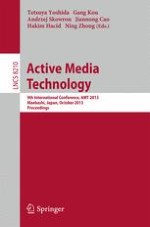This book constitutes the refereed proceedings of the 9th International Conference on Active Media Technology, AMT 2013, held in Maebashi, Japan, in October 2013. The 26 revised full papers presented together with 2 short papers, 16 workshop papers, and 12 special session papers were carefully reviewed and selected from numerous submissions. The papers are organized in topical sections on active computer systems, interactive systems, and application of AMT based systems; active media machine learning and data mining techniques; AMT for semantic web, social networks, and cognitive foundations. Additionally, the main topic of the workshop papers is: intelligence for strategic foresight; and for the special session papers: technologies and theories of narrative; evolutionary computation and its application; and intelligent media search techniques.
